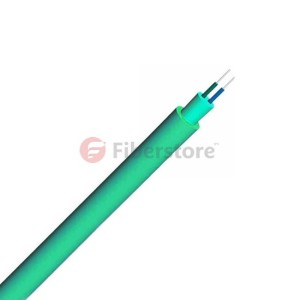Building cabling and outside plant cabling will exist in the entrance facility or among the equipment room where the two equipments are connected. The choice of building optical fiber components are affected by several factors, such as the choice of communications equipment, physical routing of the cable plant and buildingcodes and regulations. And if the design is a company network (LAN), the desing is likely to include a fiber optic backbone connecting computer rooms to cabling closets. The cabling closets house switches that convert the fiber backbone to UTP copper for fiber cable connected desktops and either copper or fiber to wireless access points. Some desktops, especially in managing or designing departments, it may require fiber to the desktop for its greater bandwidth. Extra fiber cables may be required for some security systems (alarms, access systems or CCTV cameras) and building management systems.
In the design of OSP, we must consider the choice of fiber optic cable. Most of buildindings network use multimode fiber cables, nowadays many users install hybrid cables with single mode fiber cables for future expansion. The 62.5/125 micron fiber (OM1 fiber optic cable) that has been used for almost two decades has mostly been suoerceded by the new 50/125 laser optimized fiber (OM3 or OM4 Fiber Optic Cable), as it supplies lots of bandwidth/distance advantages. The applications of fiber cables in premises is common either distribution or breakout fiber cable. Amout of fiber cords can be a problem, because backbone cables use many fiber cables now, future expansion and spares, it is a popular choice for making distribution cables. The following picture is OM4 multimode fiber cable. The folloing picture show as OM4 multimode indoor cable, more info will be in Product details page.
On all Indoor Cable, the fiber cable must be rated as fire-retardant per the NEC, CEC or other buildings codes. At the terms of NEC, indoor cables are common rated as OFNR unless the cable in air-handing areas above ceilings, and it is necessary to OFNR (plenum).
The choice of fiber optical connectors is changeable. ST and SC connectors are succumbing to the success of the smaller LC connector. Because of most fast (include giagbit and above) equipment use LC connector, the fiber cable factories who use them only one connector to need support. Building fiber optic cables only need to run from the copper cable alone to prevent crushing. Some applications may need to install fiber optic cables inside conduit, which need to care it to reduce bends as well as possible, to provide intermadiate pulls to limit pulling force or use fiber optic cable lubricants.
Required installation components will need fiber optic cables connector to choose. Buildings run are generally point-to-point and are not spliced. if it is possible, allow room for large radii in the patch panels or wallmounted boxes to minimize stress on the fibers. Choose hard ware that is easy to enter for moves, adds and changes but lockable to prevent intrusion. In premises applications, it is worth considering a pre-terminated system. These use backbone cables terminated in multifiber connectors and preterminated patch panel modules. If the facility layout is properly designed, the cable factory designs properly, the cable manufacturer can work with you to create a “plug and play” system that needs non-site termination and the cost may be very competitive to a field terminated ststem.
Fiberstore design and manufactures, and sells a broad portfolio of optical communication products, include all the fiber components in cabling management, such as fiber optical cables, optical transceivers and modules and other Fiber Optic Cable Products. In addition, Fiberstore is doing promotional activities of 30% of the before price in order to thanks for customers’ supports in these years. Fiberstore has high cost performance and more info at www.fiberstore.com

